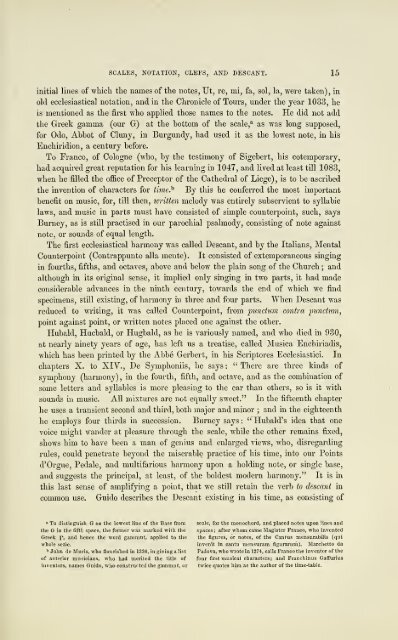Popular music of the olden time. A collection of ancient songs ...
Popular music of the olden time. A collection of ancient songs ...
Popular music of the olden time. A collection of ancient songs ...
You also want an ePaper? Increase the reach of your titles
YUMPU automatically turns print PDFs into web optimized ePapers that Google loves.
SCALES, NOTATION, CLEFS, AND DESCANT. 15<br />
initial lines <strong>of</strong> wMch <strong>the</strong> names <strong>of</strong> <strong>the</strong> notes, Ut, re, mi, fa,<br />
sol, la, were taken), in<br />
old ecclesiastical notation, and in <strong>the</strong> Chronicle <strong>of</strong> Tours, under <strong>the</strong> year 1033, he<br />
is mentioned as <strong>the</strong> first who applied those names to <strong>the</strong> notes. He did not add<br />
<strong>the</strong> Greek gamma (our G) at <strong>the</strong> bottom <strong>of</strong> <strong>the</strong> scale," as was long supposed,<br />
for Odo, Abbot <strong>of</strong> Cluny, in Burgundy, had used it as <strong>the</strong> lowest note, in his<br />
Enchiridion, a century before.<br />
To Franco, <strong>of</strong> Cologne (who, by <strong>the</strong> testimony <strong>of</strong> Sigebert, his<br />
cotemporary,<br />
had acquired great reputation for his learning in 1047, and Uved at least till 1083,<br />
when he filled <strong>the</strong> <strong>of</strong>fice <strong>of</strong> Preceptor <strong>of</strong> <strong>the</strong> Ca<strong>the</strong>dral <strong>of</strong> Liege), is to be ascribed<br />
<strong>the</strong> invention <strong>of</strong> characters for <strong>time</strong>y By this he conferred <strong>the</strong> most important<br />
benefit on <strong>music</strong>, for, till <strong>the</strong>n, written melody was entirely subservient to syllabic<br />
laws, and <strong>music</strong> in parts must have consisted <strong>of</strong> simple counterpoint, such, says<br />
Bui-ney, as is still practised in our parochial psalmody, consisting <strong>of</strong> note against<br />
note, or sounds <strong>of</strong> equal length.<br />
The first ecclesiastical harmony was called Descant, and by <strong>the</strong> Italians, Mental<br />
Counterpoint (Contrappunto alia mente).<br />
It consisted <strong>of</strong> extemporaneous singing<br />
in foui-ths, fifths, and octaves, above and below <strong>the</strong> plain song <strong>of</strong> <strong>the</strong> Church ;<br />
and<br />
although in its original sense, it implied only singing in two parts, it had made<br />
considerable advances in <strong>the</strong> ninth century, towards <strong>the</strong> end <strong>of</strong> which we find<br />
specimens, still existing, <strong>of</strong> harmony in three and four parts.<br />
When Descant was<br />
reduced to wi'iting, it was called Counterpoint, from punctum contra punctum,<br />
point against point, or written notes placed one against <strong>the</strong> o<strong>the</strong>r.<br />
Hubald, Hucbald, or Hugbald, as he is variously named, and who died in 930,<br />
at nearly ninety years <strong>of</strong> age, has left us a treatise, called Musica Enchiriadis,<br />
which has been printed by <strong>the</strong> Abbe Gerbert, in his Scriptores Ecclesiastici. In<br />
chapters X. to XIV., De Symphoniis, he says: "There are three kinds <strong>of</strong><br />
symphony (harmony) , in <strong>the</strong> fourth, fifth, and octave, and as <strong>the</strong> combination <strong>of</strong><br />
some letters and syllables is more pleasing to <strong>the</strong> ear than o<strong>the</strong>rs, so is it with<br />
sounds in <strong>music</strong>. All mixtures are not equally sweet." In <strong>the</strong> fifteenth chapter<br />
he uses a transient second and third, both major and minor ;<br />
and in <strong>the</strong> eighteenth<br />
he employs four thirds in succession. Burney says :<br />
" Hubald' s idea that one<br />
voice might wander at pleasure through <strong>the</strong> scale, while <strong>the</strong> o<strong>the</strong>r remains fixed,<br />
shows him to have been a man <strong>of</strong> genius<br />
and enlarged views, who, disregarding<br />
rules, could penetrate beyond <strong>the</strong> miserable practice <strong>of</strong> his <strong>time</strong>, into<br />
our Points<br />
d'Orgue, Pedale, and multifarious harmony upon a holding note, or single base,<br />
and suggests <strong>the</strong> principal, at least, <strong>of</strong> <strong>the</strong> boldest modern harmony." It is in<br />
this last sense <strong>of</strong> amplifying a point, that we still retain <strong>the</strong> verb to descant in<br />
common use. Guide describes <strong>the</strong> Descant existing in his <strong>time</strong>, as consisting <strong>of</strong><br />
^ To distinguish G on <strong>the</strong> lowest line <strong>of</strong> <strong>the</strong> Base from scale, for <strong>the</strong> raoiiochord, and placed notes upon lines and<br />
<strong>the</strong> G in <strong>the</strong> fifth space, <strong>the</strong> former was marked with <strong>the</strong> spaces ; after whom came Magister Franco, who invented<br />
Greek r, and hence <strong>the</strong> word garamut, applied to <strong>the</strong> <strong>the</strong> figures, or notes, <strong>of</strong> <strong>the</strong> Cantus mensurabilis (qui<br />
whole scale. invenit in cantu mensuram figurarum). Marchetto da<br />
* John de Muris, who flourished in 1330, in giving a list Padova, who wrote in 1274, calls Franco <strong>the</strong> inventor <strong>of</strong> <strong>the</strong><br />
<strong>of</strong> anterior <strong>music</strong>ians, who had merited tlie title <strong>of</strong> four first <strong>music</strong>al characters: and Franchinus Gafl^urius<br />
inventors, names Guido, who construf ted <strong>the</strong> gammut, or<br />
twice quotes him as <strong>the</strong> author <strong>of</strong> <strong>the</strong> <strong>time</strong>-table.

















